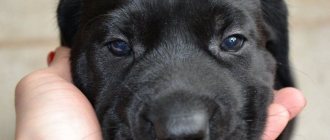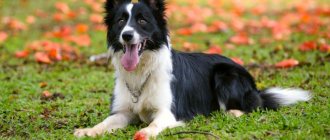Large, beautiful, friendly dogs can often be seen in photographs and pictures depicting happy, friendly families. The Labrador breed, whose characteristics usually begin with positive traits, is considered ideal for families with children. Is it really?
From our article you will learn everything about Labrador dogs. We will tell you what kind of character and temperament a Labrador has, what makes these dogs good, what types of breed there are, what you need to know about the disadvantages of these dogs.
General information
Labrador is a powerful and large breed . It has a rather attractive exterior and is popular among dog breeders. The animals do not require special care; they are easy-going, have an easy-going character and a good disposition. They are loyal, devoted friends and are excellent at home training.
A Labrador will be able to settle normally in an apartment only if its owner organizes appropriate care and strictly adheres to the daily routine. This breed is very active , for normal development the dog will need long walks, during which he can relieve himself, run around and frolic in the wild, which is impossible to do in an apartment.
In addition, this is a rather delicate breed, it cannot be kept on a leash - the dog requires special attention from the owner. Animals do not need special care, especially when they grow up, but still you need to devote quite a lot of time to your pet.
Truth and myths about the breed
You can often hear that dogs of this breed are trained to be guide dogs because they do not require long training for this. They say they are born ready-made trained dogs. It is a myth! No, dogs are first carefully selected for their temperament, and then trained for a long time, systematically over several years.
Animals are trained, taught complete obedience and tolerance. And only then are they handed over to blind people as assistants. And representatives of the Labrador breed are chosen for this role because of their good-natured nature, tolerance and complete lack of aggression towards humans.
The love of water and bathing has served to spread another myth. They say that dogs of this breed are excellent swimmers and will not miss a single body of water without swimming in it. Special membranes between the toes help animals swim well. Dogs can dive and retrieve objects from the bottom of a pond. It is so beautiful!
In reality, everything looks like this - these dogs will climb into any ditch, puddle, or swampy pond and will happily swim there, despite the owner’s dissatisfaction. Not everyone will like this animal behavior. Thick wool does not get wet, and dogs are not afraid of dirt. To be fair, we note that dogs also bathe in clean water with great pleasure; they can sit in the master’s bathroom for hours or jump into an ice hole in winter.
Content Benefits
Most people who dream of owning a Labrador believe that this is the best breed. Attractive appearance, devotion to the owner, high intelligence, cheerful character. In this case, this list of advantages can be supplemented:
- If you need the perfect companion , then the Labrador is best suited for this. Even as a puppy, the dog quickly becomes attached to its owner and pleases its owner with its devotion throughout its life.
- Labrador is an active dog that requires constant walks, regardless of weather conditions. If you lead a healthy lifestyle and maintain physical fitness, then your pet will be happy to share these aspirations, being a reliable running partner.
- Like all breeds with a straight, medium-length coat, this dog does not require grooming , which makes caring for its thick coat much easier. To maintain shine and beauty, you need to comb your pet once every 3 weeks using a furminator. The device perfectly removes dead fur from the surface, thereby improving the appearance of the coat. After walks in nature, the fur should be combed with a metal comb, this will help get rid of thorns.
- The animal is unpretentious in nutrition, as it has a good appetite . You can give your pet homemade food or dry food.
- Puppies quickly learn commands , but training must begin almost from a few weeks of the pet’s life.
Labrador - characteristics and description of the breed
Big, kind, friendly, calm, active, positive - all these are the characteristics of the Labrador dog that most often come to mind when it comes to this breed. Next, we will give a detailed description of the appearance and character of the Labrador dog and talk about the characteristics of its temperament.
Description of the Labrador Retriever dog breed
The Labrador Retriever is a dog with a well-developed but compact body, harmoniously built, without excess weight. A distinctive feature of the breed is its developed intelligence and expressive, intelligent eyes of a dark shade. An active, dexterous dog never shows aggression towards people, in any situation he is human-oriented and wants to please him. In the worldview of a dog, a Labrador and a person should be together and inseparable.
Types of Labrador Retriever by color type
The European breed standard describes three main colors that a purebred purebred Labrador can have. One of the Labrador colors has several varieties. The coat of all these varieties should be thick, short, hard to the touch, and glossy.
Types of Labrador colors recognized by the breed standard:
- Solid black. Large black Labrador dogs are not so common, but they are purebred representatives of the breed.
- Fawn Labrador Retriever. The most common coat color. According to the FCI standard, fawn color includes dogs whose coat color varies from light cream to fox-red. However, at an exhibition, a bright red Labrador retriever may be rejected by experts and recognized as not meeting breed standards.
- Brown. This beautiful color can be called liver or chocolate.
Important: all types of colors must be free of spots. All that is allowed is a small white spot on the dog's chest.
Related article:
Cane Corso - character of the breed, behavior, attitude towards the owner and children . Perhaps the Labrador breed, whose distinguishing characteristic is kindness, but you need a reliable guard, then we advise you to pay attention to the Cane Corso breed. Read about it in a separate article.
Types of breed by nature of use
In the USA, where Labradors are considered the most popular breed, there are two types of dogs:
- "English type." Show dogs bred for the show ring. In America they are called English Lab, in England - Show lab. Distinctive characteristics of this type: clearly defined “otter” tail, wide skull, wide nose, expressive “kind” eyes.
- "American type". Working dogs for use in the field. Dogs with a less dense build, without a pronounced otter tail, with a narrower head.
Both types are distinguished by friendliness, good nature, positive temperament and activity.
Breed varieties not recognized by the FCI standard
Deviations from the standard include animals with an unusual color or special coat.
- Labrador retrievers with the fluffy gene. Fluffy (fluff, translated from English) gene is responsible for the structure and length of the coat. Dogs with this genome look like plush toys and have beautiful curly hair. Such dogs are kept exclusively as pets and are not allowed to participate in exhibition activities.
- Gray retrievers. Gray dogs are recognized only in the USA. In our country and in Europe, this is a breed marriage. This coat color was obtained as a result of mating chocolate dogs with representatives of a breed of a different shade. The color of the coat looks beautiful and varies from silver to ash.
- Spotted dogs. Animals with spots or tri-color Labradors are also a breed defect.
- Dudley colored dogs. Fawn dogs with pink or chocolate “lining” around the lips and eyes can get good marks at shows, but they are not awarded titles. They look like albino dogs, but they do not have the health problems associated with albino dogs.
Important: unlike “dudleys,” albinos do not have “rimming,” and their eye color is necessarily blue.
Labrador mixed breed
This category includes puppies resulting from the mating of individuals of two different breeds, one of which is a purebred Labrador.
Let's list the most interesting hybrids:
- "Taxo Labrador." Taxolabras and labrotaxes are the result of crossing two breeds that are completely different from each other. These mestizos have an unusual appearance and a unique character, in which you can find features of dachshunds and Labradors. The mixture turned out to be contradictory. Dogs love to swim, like retrievers, but are afraid to go out in the rain, like dachshunds. They have a sly, impudent face, but the dogs behave with reserved dignity. It is difficult to guess which breed's traits will appear more in this union.
- "Labrodoodle." An interesting cross between a poodle and a labrador. The creators of the hybrid were unable to achieve recognition of this interesting species. Externally, the offspring from a hybrid mating can look like both poodles and retrievers.
- “Likadors” are a cross between a husky and a labra. Active and cheerful pets are completely unsuitable for either the role of watchmen or the role of security guards. These are companion animals.
- Spaniel hybrid. As a result of this mating, cheerful and friendly animals with a funny exterior are obtained.
- Mixed Labrador and Rottweiler. Mating representatives of these two breeds produces offspring with an unpredictable character.
- Hybrid of Husky and Retriever. Friendly mixed breeds can exhibit husky willfulness and be prone to running away and disobedience.
Important: none of the hybrids are allowed for exhibition activities!
Labrador - characteristics of the breed
Disadvantages of the breed
If you decide to get a Labrador, you need to know that this breed has certain disadvantages. This dog is not suitable for people who are accustomed to leading an inactive lifestyle, since the life of a Labrador without sufficient physical activity and regular walks simply cannot be imagined.
It is believed that this breed has excellent health, but this does not exclude a large list of diseases. The main diseases include:
- Licking granuloma.
- Joint dysplasia.
- Retinal atrophy.
- Hypothyroidism.
Also, these dogs have a tendency to obesity, which leads to the development of joint pathologies.
A Labrador requires high-quality nutrition, and it can eat about 500 g of food . That is, a Labrador is unlikely to be suitable for people with limited financial resources, since maintenance is quite expensive.
Shedding is another feature of the breed. An adult dog sheds 2-3 times a year . Moreover, this begins to be accompanied by significant hair loss. Wool can remain on the floor, bed, furniture.
Since Labradors are very social animals, this breed is not suitable for people who are often away from home.
Labrador - character description
You can often come across the statement that a Labrador's character traits depend on its color. They say that black Labradors have a calmer, more reserved character, while the red Labrador Retriever dog has an uncontrollable temperament and hyperactivity. This is one of the myths!
In fact, the character of Labradors does not depend on the color of the dog's coat. Regardless of color, dogs of this breed have a friendly, sweet character. They are not characterized by aggression towards humans and other pets. Because of these breed qualities, dogs are used in canistherapy, as guides for blind people, and in nursing homes.
A well-trained adult Labrador Retriever will never leave the person he is helping. The dog will be patient, obedient and diligent. Labradors do an excellent job as a helper dog for a person with disabilities.
Athletically built dogs have endurance, courage and good sports characteristics. They are used in search and rescue work; dogs can accompany a person on long hikes and hunts, and run with him over short and long distances. Representatives of this breed have proven themselves well in dog sports: agility, overcoming obstacle courses, obedience.
A trained adult Labrador Retriever has the ability to carry objects very carefully and carefully, which makes it possible to use dogs to neutralize explosive objects. And its ability to find and track objects by smell makes animals indispensable in customs activities and drug control.
Speaking about the nature of a Labrador, we need to mention the natural stubbornness of these pets. They can be stubborn and refuse to do what their owner requires of them. Most often this happens if the dog wants to pick up something inedible on the street. Lab owners note that a leash during a walk is needed not so that the dog does not pose a danger to others, but in order to pull the dog away from what he is trying to pick up from the ground in time.
Labrador's attitude towards children and other pets
An active, youthfully playful breed of dog retains a youthful temperament in adulthood, which children really like. Dogs happily participate in all children's games and amusements, keep company on walks and are ready to frolic for hours.
Smart pets understand that small children may accidentally cause pain while playing, but they will not bite back. Labradors will prefer to move to a safe distance if the baby wants to pull the dog by the tail. Dogs comment on their dissatisfaction with the child’s actions by quietly barking and do not use their teeth and claws.
There is no need to talk about whether the Labrador is a dangerous breed or not. With proper training and education, a Labrador will easily become a responsible nanny for a baby and a best friend for a teenager. History has recorded cases where dogs protected children by keeping them away from sources of danger.
The dog's friendly attitude extends to all members of the owner's family, which includes other pets. Labradors sincerely love everyone and believe that those around them reciprocate their feelings. Therefore, dogs do not chase the owner’s cats, they can be friends with them and sleep in an embrace.
Types of Labradors by coat type
According to the accepted standard, Labrador wool has two types of hair:
- the main coat is short in length, with coarse hair, lying close to the body;
- soft undercoat, not curly, repels water well.
A purebred Labrador is always smooth-haired and short-haired (hair length does not exceed 4 cm). Curly coat is considered a defect and such an individual is not allowed for exhibitions.
Golden retrievers (red golden retrievers are very popular companion dogs), which are mistakenly classified as a Labrador breed, can be fluffy and long-haired. In fact, these are different types of dogs. It is enough to compare photos of representatives of the breeds to be convinced of this.
The Golden Retriever is lighter, petite and shaggy compared to the Labrador. The latter has not lost its working qualities and can be used for waterfowl hunting. Retrievers are playful dogs used as companions.
How much does a Labrador weigh: sizes of a puppy and an adult dog
Pros and cons of living in an apartment
Reviews from owners about Labradors are often positive.
These are unique, friendly dogs that bring a lot of joyful moments into a boring life. Keeping these dogs in an apartment is no different from keeping a dog in your own home: the dog will still sleep either with you or near your bed. Enclosures , and especially sitting on a chain, for animals
The advantages of the breed include the following:
- easy care;
- obedience and restraint;
- kind and lively character;
- beautiful appearance.
The disadvantages of Labradors are mainly determined not by the breed of the dog, but by its upbringing. The disadvantages of keeping dogs in an apartment include the following:
- The energy and activity of young dogs, which force them to take long and varied walks in any weather.
- Possible damage to property. The puppy needs space for activity, and if it is not provided properly, then all the personal belongings of the owners will be used.
- Expensive food.
But all these disadvantages pale in comparison to how much goodness and happiness Labrador brings to every home. Adult dogs turn into stately, beautiful dogs that evoke the admiration of others and the pride of their owners.
Reviews from Labrador owners
I also have a Labrador dog. This is not only a beautiful, but also the smartest and most loyal dog. The author of the article clearly noted that the Labrador is first and foremost a friend and companion. And keeping it in an apartment is really very simple, even in a one-room apartment. Labradors are completely unpretentious and at the same time very attached to their owner.
Alla Mogileva. Moscow
An adult Labrador is hard. Constant wool, dirt from walks, damaged things and furniture. In any weather, I walk for 1.5-2 hours. But I was ready for difficulties; any animal in the house means responsibility, giving up your habits.
This kind, smart look with which Nick looks at me is dearer than anything in the world. And for this reason you get up every day at 5 am to run and walk with the dog.
Andrew Vladimirovich. Saratov
We have been the owners of Labrador for a year now. There was so much torment with the little puppy, as if a small child had appeared in the house again. But now he has grown up, and it has become much easier. The whole family walks, runs, and plays.
Of course, there is not enough space in the apartment, but we knew that the dog would be large.
And even regular cleaning is no longer frustrating. The main thing is that the dog is very kind and gets along well with children. Valentina Petrova. Saint Petersburg
How much does a puppy cost?
A puppy with documents and pedigree, as a rule, costs between 25-30 thousand rubles. A dog without documents can be bought cheaper, but there is no guarantee that an adult will have all the characteristics of the breed.
Litter from exhibition champions costs 20 thousand rubles more. Puppies from titled parents can also be taken to various exhibitions.
Main characteristics
The height at the withers for males is 56-57 cm, for females – 54-56 cm. The standard acceptable body weight for males is 27-40 kg, for females – 27-35 kg. The average life expectancy of dogs of this breed reaches 13 years.
The Labrador has a massive build: powerful paws, a wide muscular back and a well-developed chest. Due to these body features, Labradors are strong and resilient dogs that are able to run fast, jump over obstacles, swim and even dive.
There is a misconception that the Labrador is an excellent watchman who will skillfully protect the house from unwanted guests, but this is not so. Despite its large size, the Labrador is a poor watchdog because it is not characterized by aggression.
Photo
You have become acquainted with the Labrador breed, the photo of which is presented above. A responsive, trusting, friendly, kind dog with an incredibly “cozy” appearance is the dream of any owner. Labrador is very family-oriented and loyal. This explains why young couples prefer to have this breed.
Interesting facts about the breed
The Labrador is the only dog with webbed feet. This structural feature makes them unsurpassed swimmers in the canine world.
Dogs love to hold objects in their mouths. They have a soft jaw, but the owner must ensure that the pet has more toys. Otherwise, he will switch his attention to other objects in the house.
Labradors have a very high pain threshold. It is not surprising that they are selfless and can rush into the very center of a fire or disaster in order to save people.
They have a sense of smell that is 25% higher than that of the German Shepherd.
The breed, along with the English bulldog, Pekingese, boxer, and German shepherd, is among the TOP 7 most popular breeds.
Diseases and life expectancy
The Labrador Retriever is a relatively healthy breed of dog. Despite their physical endurance, they suffer from the following breed diseases:
- dysplasia of the hip and elbow joints;
- bloating;
- epilepsy;
- angiosarcoma;
- pododermatitis;
- atopy;
- food allergies;
- mast cell cancer;
- obesity;
- lipoma;
- cataract;
- lymphosarcoma.
A stroke in a Labrador is possible at any age: both young and old. Possible causes: brain injury and tumor, poisoning, blockage of blood vessels, blood diseases, obesity, increased blood pressure. A sign of a stroke is an excited state, lack of response to commands, the dog rests its head on the floor or wall, the limbs do not obey well, the pupils take on different sizes, the dog seems to be arching. In this case, you should immediately consult a doctor.
Also, Labrador Retrievers often have festering eyes. The cause may be a domestic injury, foreign body penetration, entropion of the eyelid, food allergy and conjunctivitis. After symptoms appear, you need to rinse the eye 3-4 times with chamomile infusion, pull back the eyelid, apply one percent tetracycline ointment to it and massage it lightly.
You should not allow your dog to rub its eyes.
On average, Labradors live 10-13 years.
Education and training
Representatives of the breed are distinguished by great intelligence and intelligence, so training and raising a Labrador will be easy.
From the first minutes of a puppy’s appearance in the house, he needs to be accustomed to the daily routine, place, toilet, and his nickname. Call your baby by name more often, and reward him with a treat and pet him for completing the action. To make your dog get used to it faster, play with it, teach it to come to you when called, and never offend it. Labrador puppies are very inquisitive by nature and do not tolerate boredom, so to prevent your baby from losing interest in you, make your walks and games varied, this way you will teach your pet to always keep you in sight.
The main commands that a dog must understand are: “Sit”, “Lie down”, “Place”, “Ugh!”, “Pick up”. They should be clear, clear, without using long sentences - this will only confuse the puppy.
How to train a Labrador?
The sooner training begins, the better. It is not necessary to arrange special lessons - a Labrador puppy will respond well to training during the socialization process. Sometimes it is enough to repeat a command a couple of times for your pet to remember it for life. Labradors are not only smart, but also cunning - they work best for pieces of treats, while the amount of work will be reduced to a minimum, achieving a maximum of tasty reward - homemade crackers, a piece of meat or boiled liver. You should not give sweets (cookies, sweets, cakes).
The main problems of dogs are their desire to pick up food from the ground and attempts to escape from their beloved owner. However, even with minimal contact between the owner and the pet, these troubles can be avoided.
No matter how cute and charming your pet is, never allow him to do anything that you would never allow an adult dog to do. Do not make allowances for age, stop attempts to sleep in your bed, gnaw property, pick up pieces from the floor and eat food from the hands of strangers, jump on family members and guests, and bite. Remember that Labradors love water, but uncontrolled swimming can make it extremely difficult to lure the dog to shore.
For the Labrador breed, training must follow the following rules:
- For every correctly performed action, the dog must be rewarded.
- Learning new commands occurs only after the old ones have been consolidated.
- The first lesson should be carried out in a calm environment so that the pet is not distracted.
- The lesson is carried out before feeding.
- The process should not be long so that the dog has the opportunity to rest.
- The student must be punished or rewarded immediately after he performs any action.
- You can’t shout at the dog, just tell it in a stern voice: “Ugh!” – Labradors have a great sense of intonation.
- You can't hit your pet. If you want to scare him, all you have to do is slap him on the head with a rolled-up newspaper.
When asking your Labrador to perform a certain action, be firm and persistent, otherwise you will have problems with his obedience in the future.
Estrus, mating and birth
The first heat in Labradors can begin after the change of teeth or between the ages of 1 and 2 years. Usually there are 1-2 heats per year. The first mating takes place after the female turns 20 months old, and the male turns 18. The best time for mating is 10-15 days of estrus.
Mating is carried out on the territory of the male dog. A few days before mating, he is fed high-protein food or the amount of meat is increased. It is not recommended to feed the groom before mating.
If the owner is inexperienced in mating, he should invite an instructor.
Pregnancy in Labradors lasts about 64 days. If the female carries many puppies, labor may begin earlier (on the 57th day); if there are few, then later (on the 66th). Contractions last from 10 hours to a day. It is not recommended to give birth on your own: there is a high risk of unforeseen situations. The owners may not have the necessary medications and equipment.
How to care for Labradors
Care will not be difficult. It is enough to brush your Labrador Retriever once a week to keep its coat looking beautiful and neat.
Labrador ears need to be cleaned with a special lotion. Usually, several such procedures per month or even less often are enough, it all depends on the degree of contamination. As for teeth, their condition also deserves attention.
Another important procedure is cutting the nails. They are shortened as they grow, and this can be done either independently or by specialists - in a veterinary clinic or grooming salon.
Experiment











